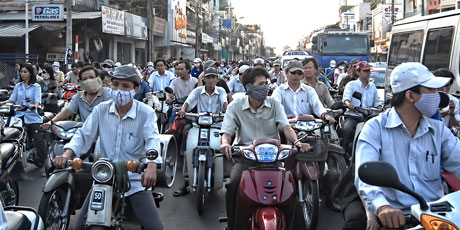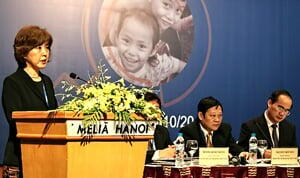HA NOI – The Imbalance of Sex Ratios at Birth (SRB) is an increasing concern in some South, East and Central Asian countries, where about 117 million women and girls are reported as “missing”, mostly in India and China. According to the most optimistic scenario, if the SRB levels were to come back to normalcy within the next ten years, men in China and India will still face a serious “marriage squeeze”, as many of them would not be able to find a partner due to a shortage of women of marriageable age for several decades. These findings were presented today in Ha Noi at the international workshop on “Skewed Sex Ratios at Birth: Addressing the Issue and the Way Forward”, organized by the Government of Viet Nam and the United Nations.
“I highly appreciate the initiative of the Ministry of Health and the United Nations in Viet Nam in organising this workshop. I hope that the experiences and lessons learned from other countries will provide a good opportunity to help Viet Nam to reshape our policy in family development and to build an effective social and health care system to bring the sex ratio at birth back to normal,” said Viet Nam’s Deputy Prime Minister Nguyen Thien Nhan at the opening of the workshop.
The biologically normal sex ratio at birth ranges from 104 to 106 boys per 100 girls. However, ratios as high as 115-120 boys per 100 girls have been observed in China (118.1 in 2009), India (110.6 in 2006-2008), Armenia (115.8 in 2008) and Azerbaijan (117.6 in 2009). In Viet Nam, the ratio was 111.2 boys per 100 girls in 2010.
According to international and national experts, the level of SRB increases in accordance with birth order. For example, in India in 2001, the SRB was 111 for the first birth, 112 for the second, and up to 116 for the third birth. In China in 2005, the SRB was 108.4 for the first birth, 143.2 for the second, and 156.4 for the third. In Viet Nam in 2009 the SRB was 110.2 for the first birth and slightly lower, at 109, for the second birth. However, for the third or later births the SRB was above 115. This observation suggests that prenatal sex selection could have been adopted by a number of couples even during their first pregnancies.
One of the main factors behind this SRB rise relates to son preference, which is deeply rooted in many Asian countries for cultural, social and economic reasons. Daughters may be seen as a liability, especially where dowries must be paid. Older parents largely rely on sons for support in terms of health care and living expenditures. And sons may be needed to perform last rites or other rituals related ancestor worship.
In addition, as many national policies support reductions in family size, many individuals have begun to use ultrasound and other sex selection technology. Furthermore, there are many social consequences for women who give birth to an unwanted girl child. In some cases, this can include violence, abandonment, divorce or even death.

“There is huge pressure on women to produce sons, which not only directly affects women’s sexual and reproductive lives with implications for their health and survival, but also puts women in a position where they must perpetuate the lower status of girls through son preference,” said Nobuko Horibe, Director for Asia-Pacific of UNFPA, the United Nations Population Fund.
A skewed SRB will affect the population sex ratio structure in future, which, in turn, will result in a situation where there is an excess of males in society. Scarcity of women could increase pressure on women to marry at a younger age, often sacrificing educational opportunities, there may be a rise in demand for sex work, and trafficking networks may also expand in response to this imbalance.
“Governments should give top priority to developing and promoting programmes and policies to support the girl child in areas such as inheritance laws, dowries and financial and other social protection in old age that reflect a commitment to human rights and gender equality,” added Ms. Horibe.
Governments in affected countries have undertaken a number of measures to halt increasing sex ratio imbalances. However, renewed and concerted efforts are now needed by governments and civil society, including efforts to address the deeply rooted gender discrimination against women and girls which lies at the heart of sex selection.
“To keep up the momentum toward achieving Millennium Development Goal 3 on gender equality in Viet Nam, efforts need to be dedicated to changing couples’ traditional preference for male children, as well as towards empowering women’s position in the family and society as a whole. More qualitative research is also needed so we can better understand the underlying social and cultural factors behind the SRB imbalance. This will, in turn, provide a foundation for improving education activities and other interventions,” said Eamonn Murphy, United Nations Resident Coordinator a.i in Viet Nam.
For more information, please contact:
Dang Thi Bich Thuan, tel. +84 4 3823 5806, mobile 0913508947, vuTTGD@gmail.co
Nguyen Thi Hong Thanh, tel.+84 4 3822 4383 ext 117, mobile 0913 093363, tnguyen@unfpa.org


